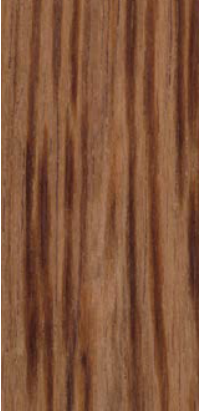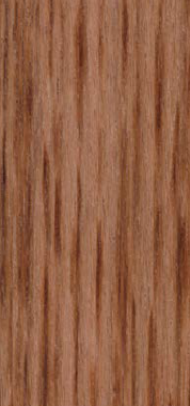Wallaba
| Family | Moraceae |
| Botanical Names | Eperua rubiginosa |
| Continent | Latin America |
| CITES | (Washington convention of 2017)
No trade Restrictions |
| Diameter | 40 to 70 cm |
| Thickness of Sapwood | 4 – 6 cm |
| Buoyancy | Does not float |
| Log Conservation | Good |
Wood Description
| Reference colour | Sapwood | Texture | Grain | Interlocked grain | Notes |
|---|---|---|---|---|---|
| Red brown | Clearly demarcated | Medium | Straight | Absent | Wood red brown to dark brown with lighter veins. Very pronounced internal stresses. Presence of resin veins Unpleasant odour when green. |
Flat Sawn

Quarter Sawn

Physical and Mechanical properties
| Property | Mean Value |
|---|---|
| Density* | 0.88 |
| Monnin hardness* | 7.0 |
| Coefficient of volumetric shrinkage | 0.42 % per % |
| Total tangential shrinkage (Ts) | 6.5 % |
| Total Radial shrinkage (Rs) | 2.3 % |
| T/R anisotropy ratio | 2.8 |
| Fibre Saturation point | 29 % |
| Thermal conductivity | 0.29 W/(m.K.) |
| Lower heating value | 19, 720 kJ/kg |
| Crushing strength* | 72 MPa |
| Static bending strength* | 120 MPa |
| Longitudinal modulus elasticity* | 18, 450 MPa |
Natural durability & Treatability
| Resistance to decay | Class 1 – very durable |
| Resistance to dry wood borers | Class D – durable (sapwood demarcated, risk limited sapwood) |
| Resistance to termites | Class D – Durable |
| Treatability | Class 4 – non-treatable |
| Use class covered by natural durability | Class 4 –in ground or fresh water contact |
Notes
This species is listed in the NF EN 350 standard. Natural durability classes and use class mentioned are those of Eperua falcata. Eperua grandiflora and Eperua rubiginosa have a poorer durability. According to the European standard NF EN 335 of May 2013, performance length might be modified by conditions in which it is used. This species naturally covers the use class 5 (wood permanently or regularly submerged in salt water, sea water or brackish water) due to its high density.
Preservation Treatment
| Against dry wood borer attacks. | This wood does not require any preservation treatment. |
| In case of temporary humidification | This wood does not require any preservation treatment |
| In case of permanent humidification | This wood does not require any preservation treatment |
Sawing and Machining
| Blunting effect | Fairly high |
| Tooth for sawing | Stellite tipped |
| Machining tools | Tungsten carbide |
| Suitability for peeling | Not recommended or without interest |
| Suitability for slicing | Not recommended or without interest |
| Notes | Sawing and machining requires powerful equipment. Resin may clog saw teeth of saws and cutters. Resin exudations are no more problematic on dry wood. Internal stresses released limits yield with sawing. |
Drying
| Drying rate | Slow |
| Risk of distortion | No specific risk |
| Risk of case hardening | High risk |
| Risk of checking | Slight risk |
| Risk of collapse | No known specific risk |
| Suggested drying schedule | Schedule # 6 |
Assembling
| Nailing/ Screwing | Good but pre – boring necessary. |
| Notes | Tends to split with nailing. High specific gravity: important that gluing be performed in compliance with the code of practice and instructions for the glue used. |
Cross sections of Eperua rubiginosa


Commercial Grading
Sawn timber appearance grading
According to NHLA grading rules (2015) Possible grading: FAS, Select, Common 1, Common 2, Common 3. In French Guiana, the local name of this species is "Wapa". Grading is done according to local rules "Bois guyanais classés". Possible grading: Choice 1, choice2, choice 3, choice 4
Fire Safety
| Conventional French grading | Thickness > 14 mm: M3 (moderately inflammable)
Thickness < 14 mm: M4 (easily inflammable) |
| Euroclass grading | D-s2, d0
Default grading for solid wood that meets requirements of European standard NF EN 14081-1 (April 2016): structural graded timber in vertical uses and ceilings with minimal mean density of 0.35 and minimal thickness of 22 mm. |
Visual structure grading
According to French standard NF B 52- 001-1 (2011) and associated national standards, strengths classes D40 can be provided by visual grading.
Main End uses
- Shingles
- Heavy carpentary
- Exterior joinery
- Cooperage
- Sleepers
- Stakes
- Decking
- House framing
- Poles
Notes
Careful sanding and filling are recommended